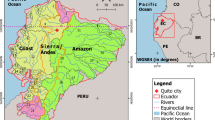Abstract
It is well known that soil compaction affects root growth and disrupts the activity of soil microfauna and microorganisms, resulting in yield loss. With the more intensive use of heavy machines in agriculture and forestry, the risk of soil compaction is increasing. In this study, precompression stress (Pc) was chosen as an indicator of the susceptibility of soils to compaction and was calculated using pedotransfer functions (PTFs). PTFs involve eight variables related to the hydraulic and mechanical behaviour of soils: organic matter content, bulk density, air capacity, available water capacity, non-plant available water capacity, saturated hydraulic conductivity, cohesion, and angle of internal friction. Combining these PTFs with geostatistics and Monte Carlo simulations, Pc maps were produced at the regional scale for Wallonia in Belgium, accompanied by uncertainty quantification maps. These maps were then used to produce compaction risk maps based on common scenarios. The results showed that the modal Pc map was coherent with the spatial distribution of the main variables, namely soil texture and organic matter content. The risk maps enabled areas with a compaction risk in both agricultural and forestry contexts to be identified. These maps could be useful in drawing up soil protection measures and policies.






Similar content being viewed by others
References
Aitchison J (1986) The statistical analysis of compositional data. Chapman & Hall, London
Aitchison J (1997) The one-hour course in compositional data analysis or compositional data analysis is simple. CIMNE, pp 3-35
CNSW (2013) Carte numérique des sols de Wallonie. Service Public de Wallonie. http://geoportail.wallonie.be/cms/render/live/fr/sites/geoportail/contents/metadata/plainData/38c2a87e-d38a-4359-9899-9d4a6b9f0c2a.html
COM (2006) 232 final. http://eur-lex.europa.eu/LexUriServ/LexUriServ.do?uri=COM:2006:0232:FIN:EN:PDF
COSW (2013) Carte d’occupation des sols de Wallonie. Service Public de Wallonie. http://geoportail.wallonie.be/cms/render/live/fr/sites/geoportail/contents/metadata/plainData/7539bf98-4d80-459f-8274-312563c2bab4.html
Cressie N (1993) Statistics for spatial data. Wiley, New York
D’Or D (2003) Spatial prediction of soil properties, the bayesian maximum entropy approach. PhD thesis, Faculté d’Ingénierie Biologique, Agronomique et Environnementale, Université catholique de Louvain
D’Or D, Destain MF (2014) Toward a tool aimed to quantify soil compaction risks at a regional scale: application to Wallonia (Belgium). Soil Tillage Res 144:53–71
D’Or D, Bogaert P, Christakos G (2001) Application of the BME approach to soil texture mapping. Stoch Env Res Risk A 15(1):87–100
Goovaerts P (1997) Geostatistics for natural resources evaluation. Oxford University Press, New York
Goutal N (2012) Modifications et restauration de propriétés physiques et chimiques de deux sols forestiers soumis au passage d’un engin d’exploitation. PhD thesis, Institut des Sciences et Industries du Vivant et de l’Environnement, AgroParisTech
Greacen E, Sands R (1980) Compaction of forest soils. A review. Aust J Soil Res 18:163–189
Hakansson I, Reeder R (1994) Subsoil compaction by vehicles with high axle load extent, persistence and crop response. Soil Tillage Res 29:277–304
Hamza MA, Anderson W (2005) Soil compaction in cropping systems—a review of the nature, causes and possible solutions. Soil Tillage Res 82:121–145
Hanquet B, Sirjacobs D, Destain MF, Frankinet M, Verbrugge JC (2004) Analysis of soil variability measured with a soil strength sensor. Precis Agric 5(3):227–246
Heuvelink G, Pebesma E (1999) Spatial aggregation and soil process modelling. Geoderma 89:47–65
Hoefer G (2010) Subsoil compaction: causes, impact, detection, and prevention. Soil Eng Soil Biol 20:121–145
Hollis J, Hannam J, Bellamy P (2012) Empirically-derived pedotransfer functions for predicting bulk density in european soils. Eur J Soil Sci 63:96–109
Horn R, Fleige H (2003) A method for assessing the impact of load on mechanical stability and on physical properties of soils. Soil Tillage Res 73:89–99
Jarvis N (2007) A review of non equilibrium water flow and solute transport in soil macropores: principles, controlling factors and consequences for water quality. Eur J Soil Sci 58:523–546
Jones R, Spoor G, Thomasson A (2003) Vulnerability of subsoils in europe to compaction: a preliminary analysis. Soil Tillage Res 73:131–143
Nawaz M, Bourrié G, Trolard F (2013) Soil compaction impact and modelling. A review. Agron Sustain Dev 33(2):291–309
Nelson D, Sommers L (1996) Total carbon, organic carbon, and organic matter. In: Methods of soil analysis. Part 2, agronomy. American Society of Agronomy, Inc., Madison, pp 961-1010
Pawlowsky V, Olea RA, Davis JC (1995) Estimation of regionalized compositions—a comparison of 3 methods. Math Geol 27(1):105–127
Stettler M, Keller T, Schjonning P, Lamande M, Lassen P, Pedersen J, Weisskopf P (2010) Terranimo–a web-based tool for assessment of the risk of soil compaction due to agricultural field traffic. In: Proceedings of AgEng 2010
Van Orshoven J, Maes J, Vereecken H, Feyen J, Dudal R (1988) A structural database of belgian soil profile data. Pedologie 38:191–206
Walvoort DJJ, De Gruijter JJ (2001) Compositional kriging: a spatial interpolation method for compositional data. Math Geol 33(8):951–966
Wösten J (2000) The hypres database of hydraulic properties of European soils. Adv Geoecol 32:135–143
Acknowledgments
This work was funded by the SPW (Service Public de Wallonie), DGARNE (Direction Générale Opérationnelle de l’Agriculture, des Ressources Naturelles et de l’Environnement). The authors also acknowledge three anonymous reviewers for their useful comments.
Author information
Authors and Affiliations
Corresponding author
Rights and permissions
About this article
Cite this article
D’Or, D., Destain, MF. Risk Assessment of Soil Compaction in the Walloon Region in Belgium. Math Geosci 48, 89–103 (2016). https://doi.org/10.1007/s11004-015-9617-7
Received:
Accepted:
Published:
Issue Date:
DOI: https://doi.org/10.1007/s11004-015-9617-7




